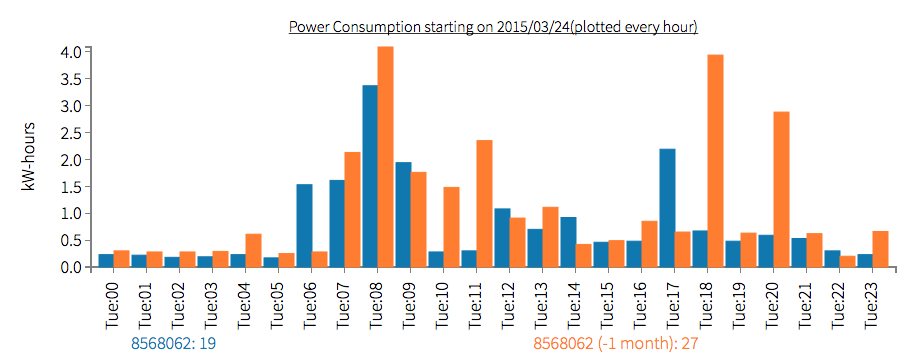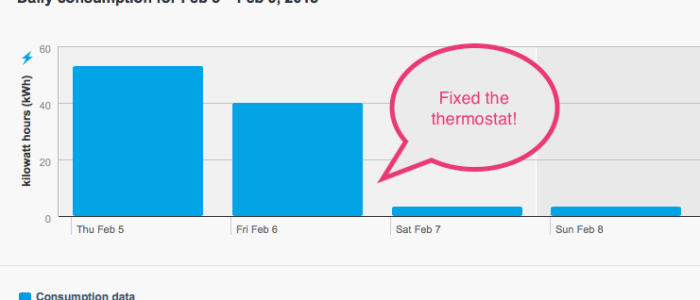
At the beginning of February I was surprised to discover that the shop was using more power daily than the earthship was! The shop is not used very much these days and should consume very little power. My initial inclination was to blame the teenagers in our house. This is a common though not always justified occurrence.
I went over to the shop to investigate and sure enough the electric baseboard heater in the office had been left on with the thermostat set at around 10 degrees. I turned the thermostat off and left, thinking I had solved the issue. A few days later I checked our Hydro consumption and to my surprise the shop was still consuming way too much power. I once again blamed the kids, who protested vehemently this time. Not being able to resolve the problem in the usual way I headed back over to the shop to investigate.
It turned out that at some point in the previous month the thermostat control had failed. Despite the thermostat being in the off position the heater had been on the entire time. The shop was an integral part of the log house business we used to operate, but it gets used pretty infrequently these days. Fixing one simple wiring issue dramatically reduced the power consumption of this building.
So, what about the earthship?
Fixing this simple problem in the shop led me to wonder how our power consumption in the house has been doing. Since moving into the earthship our residential consumption has been fairly low. When I look back to 2013 I estimated we were using around 20 kWh a day. This number represents our entire residential utility consumption (we do not use gas) and my assumption has been that the bulk of this number can be attributed to:
- the hot water tank (sadly we still have one),
- the fridge/freezer (we have old appliances and we keep waiting for them to die),
- the electric stove.
Our ultimate plan is to lower our hydro consumption to 5-10 kWh daily and then look at producing our own power. We tend to get things accomplished based on available time and money, and both items have been in short supply since moving into the earthship. So, ignoring the fact that we have some notable energy pigs in the house, how has our energy consumption been doing over the last two years?
How are we monitoring power consumption?
The Kill-o-Watt Meter
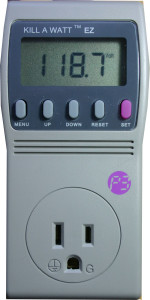 I started with a kill-a-watt meter knock-off (ours came from the Home Depot). This is a useful device because it can be plugged in to any 120 volt outlet and will measure instantaneous power consumption. By doing this I discovered that:
I started with a kill-a-watt meter knock-off (ours came from the Home Depot). This is a useful device because it can be plugged in to any 120 volt outlet and will measure instantaneous power consumption. By doing this I discovered that:
- an electric drip coffee maker uses just over 1000 watts to make coffee. As an aside: we do not usually use a drip coffee maker except that one of the kids smashed our French press while doing dishes a few weeks ago and we have been REALLY busy. Frustratingly, another one of the kids managed to break the pot for the drip coffee maker about a week ago so one of us now stands next to the coffee maker and keeps the drip valve open while the coffee is being made. Coffee addiction is not pretty. Assuming it takes about 10 minutes to make coffee, the coffee maker uses about 170 kWh to make our java. We do not leave the unit turned on to keep coffee warm but if you do, the coffee maker quickly piles on the kWh; it seems to have about a 50% duty cycle when keeping the coffee warm, meaning that the maker is on about half of the time. This means that in an hour you’ve used another 0.5 kWh of power.
- Our 36″ flat-screen LCD display uses almost no standby power.
- The box that sits on top of our TV when there is a satellite connection (I assume cable as well) is a total pig in stand-by mode, consuming more than 30 watts of energy while doing nothing. This apparently has something to do with being able to update the show schedule periodically. You have to be kidding me! Unless the TV is on this box is now powered off. The kids do not like waiting a few minutes for the show listings to update, but such is life. And given that we use the TV for The Rick Mercer Report, Murdoch Mysteries (I won’t divulge which one of us has a fondness for this show), and the odd special show, documentary, movie…we don’t actually turn the unit on very many times in a week. This may seem like a minimal power draw but picture the total power consumption across North America just to keep our electronic TV guides up-to-date … while no one is even watching TV!
- The sole desktop computer in our house was using over 130 watts of power and was not going to sleep (when it drops to a negligible amount). This was a tough one to monitor as Stephen was worried I was going to get rid of his computer. He relaxed when I just told him to enable the power save mode.
- Laptops generally seem to use about 60 watts of energy when active as do mac-mini computers.
- Everyone in the house gets annoyed with me unplugging devices to put the meter in-line, and generally think this behaviour is kind-of odd.
I really should tabulate these results but have not taken the time to do it yet.
Unfortunately, this style of meter is limited. It does not handle 240 volt loads, and it does not store measurements so that you can easily figure out what is going on over time. I ripped the unit apart to see if I could hook an arduino into the circuit and record its output. Surprisingly, I almost made this work except that I could not get the unit initialized properly on startup so I was always out by a correction factor that was apparently being loaded by the original circuit. So close and yet no cigar.
BC Hydro Consumption Data
From the kill-o-watt meter I graduated to looking closely at the consumption data that BC Hydro provides for our accounts. Initially, I thought I was wasting my time as by default the data is graphed by daily consumption and I did not think there was enough granularity of data.
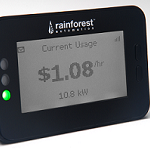 I briefly investigated the new instantaneous monitoring options available from BC Hydro but was informed that my residential account was not eligible because it was being billed as a commercial connection and commercial accounts are not supported at this time. This led to the discovery that we are being billed about 10 cents a kWh for electricity (the commercial rate) when we could only be paying about 7 cents an hour (the residential rate). Gah! I am now waiting to be switched to a residential rate for the house and when this happens I will apply again for instantaneous monitoring from BC Hydro. This could apparently take 1-2 months so I am not holding my breath.
I briefly investigated the new instantaneous monitoring options available from BC Hydro but was informed that my residential account was not eligible because it was being billed as a commercial connection and commercial accounts are not supported at this time. This led to the discovery that we are being billed about 10 cents a kWh for electricity (the commercial rate) when we could only be paying about 7 cents an hour (the residential rate). Gah! I am now waiting to be switched to a residential rate for the house and when this happens I will apply again for instantaneous monitoring from BC Hydro. This could apparently take 1-2 months so I am not holding my breath.
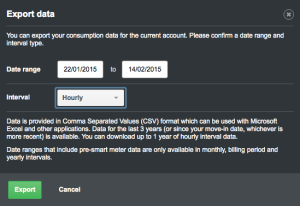 Stymied, I returned to the consumption information that BC Hydro provides on-line. At this point I discovered that the data from BC Hydro is actually recorded in one hour increments (since the installation of smart meters). Unfortunately, it is very difficult to do anything with this data online as the graphing options provided are pretty limited. I further discovered that you can download this data (as a .csv file or a spreadsheet) and then you can do whatever you want with it.
Stymied, I returned to the consumption information that BC Hydro provides on-line. At this point I discovered that the data from BC Hydro is actually recorded in one hour increments (since the installation of smart meters). Unfortunately, it is very difficult to do anything with this data online as the graphing options provided are pretty limited. I further discovered that you can download this data (as a .csv file or a spreadsheet) and then you can do whatever you want with it.
I downloaded our hourly BC Hydro consumption data and …
Wrote my own web-based monitoring tool
The last few weeks have been somewhat frustrating at our house as I developed this tool.
Sandra knew I was investigating power consumption with an eye towards evaluating a solar hot water installation. But my sudden silence on the subject and total preoccupation with my computer led to a lot of questions.
“What are you up to?” (Sandra had hip replacement surgery when all of this started and she was recovering at home during most of the time I was developing this tool.)
“Not much.” I am a firm believer that the best initial defence is obfuscation.
“No, really. What are you doing?” Sandra’s fuzziness with the narcotics following surgery were at constant war with her boredom being constrained to the house.
“Writing an on-line monitoring tool for our power consumption.” I am sometimes accused of going off on a tangent and even to me this seemed pretty weak. Sometimes the narcotics won and she fell asleep without comment. Other times she managed a few extra half-hearted questions.
Regardless, I stuck with it and now have a better monitoring tool that I hope to use down the road for monitoring branch circuits and eventually for control. Its completion coincided with Sandra’s graduation to regular OTC painkillers so I was able to answer all her questions when she started firing them at me.
What did all of this work tell me?
The first thing I noticed looking at the hourly data was that the hot water tank seems to use more power than I assumed. The most significant peaks in our daily consumption seem to correlate with our shower schedule. I started playing with the hot water by turning it off in the evening (around 6pm) and then turning it back on in the morning. I’ve discovered that I can turn the tank off at around 2pm and nobody complains about cold water for the balance of the day. Turning the tank off overnight had a noticeable (not huge) impact on our power consumption. The blue bars in the above graph are from March 25th and the orange bars are from a month earlier in February. Notice that the overnight consumption is lower because the tank is turned off and generally we are consuming less power.
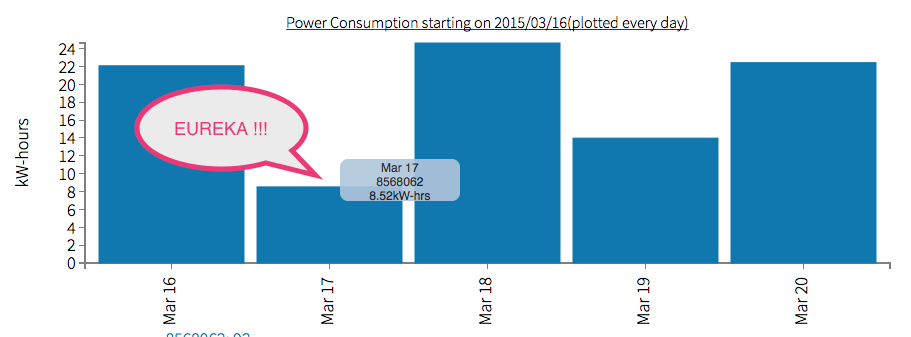 My eureka moment came in the shower (where else) while I was waiting for the hot water, which never came. I had shut the hot water off the prior evening and forgotten to turn it back on in the morning. I was the last one in the shower that morning and it was cold for me but nobody else complained. Given that it was 11:30 in the morning and most of us were going into Kamloops to visit Sandra in the hospital, I left the hot water off and in the interest of research we did no dishes after dinner. The result was dramatic, we consumed about 8 kWh that day. Apparently, heating water accounts for more than half of our daily consumption!
My eureka moment came in the shower (where else) while I was waiting for the hot water, which never came. I had shut the hot water off the prior evening and forgotten to turn it back on in the morning. I was the last one in the shower that morning and it was cold for me but nobody else complained. Given that it was 11:30 in the morning and most of us were going into Kamloops to visit Sandra in the hospital, I left the hot water off and in the interest of research we did no dishes after dinner. The result was dramatic, we consumed about 8 kWh that day. Apparently, heating water accounts for more than half of our daily consumption!
The other conclusion I’ve arrived at from all of this is that the fridge and freezer appear to use about 0.2kWh overnight with everything else turned off. This means that the fridge and freezer account for about 4-5 kWh a day (assuming the consumption is fairly constant through the day).
Initial Conclusions
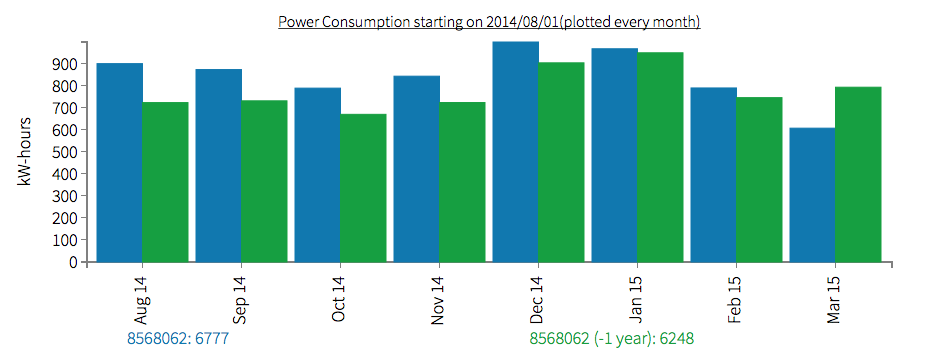 If you look at this final graph you will notice that generally our power consumption has been steadily edging up over the last year (blue bars). In the last month while I have been monitoring, it has dropped to levels not seen in over a year (green bars) and may actually be the lowest consumption month we have recorded. This tells me two things; phantom loads such as the one introduced by the satellite TV add up, and without an effective monitoring tool it is challenging to stay on top of power consumption. A lot of the electrical consumption in the house is silent and out of sight. Unless it is being monitored effectively it is easy to lose track of usage.
If you look at this final graph you will notice that generally our power consumption has been steadily edging up over the last year (blue bars). In the last month while I have been monitoring, it has dropped to levels not seen in over a year (green bars) and may actually be the lowest consumption month we have recorded. This tells me two things; phantom loads such as the one introduced by the satellite TV add up, and without an effective monitoring tool it is challenging to stay on top of power consumption. A lot of the electrical consumption in the house is silent and out of sight. Unless it is being monitored effectively it is easy to lose track of usage.
Heating water for daily use appears to be by far our single biggest use of electricity and warrants more investigation.
Smart meters have given BC Hydro an incredible amount of data about our daily life. It is creepy and I suspect no good will come of it, despite the fact it has allowed me to look at our consumption hourly.
Stay tuned. I’m trying to figure out how to collect more data on individual branch circuits and at some point I’ll post the details of how I came up with all my findings.
